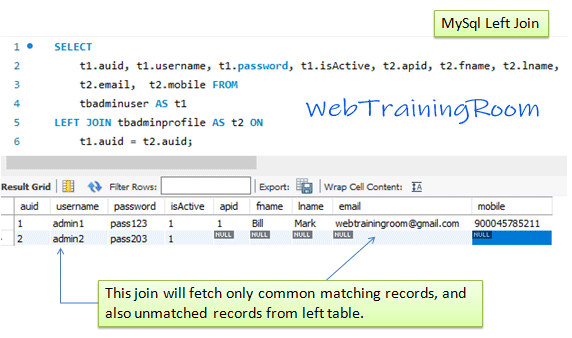

Union: The UNION operator is used to combine data from two tables with same data type. All columns are shown individually in the output. MySQL expression Table1 LEFT OUTER JOIN table2 condition The right join syntax are given below. MySQL expression Table1 INNER JOIN table2 condition The left join syntax are given below. Joins: A join is used to display columns with the same or different names from different tables. MySQL expression Table1 JOIN table2 condition The inner join syntax are given below. Lesson learned: using NATURAL JOIN requires carefulness. JOINS and UNION Examples What is the difference between JOINS and UNION. Thus, when NATURAL JOIN joins these 2 tables, it requires both customer_id and last_update be equal for 2 rows to be matched, and of course, no pair of rows satisfies this criterion. This is because, in this Pagila database, every table has a column named last_update. For example: SELECT FROM t1 LEFT JOIN (t2, t3, t4) ON (t2.a t1.a AND t3.b t1.b AND t4.c t1.c) is equivalent to: SELECT FROM t1 LEFT JOIN (t2 CROSS JOIN t3 CROSS JOIN t4) ON (t2.a t1.a AND t3.b t1.b AND t4.c t1.c) In MySQL, JOIN, CROSS JOIN, and INNER JOIN are syntactic equivalents (they can replace each other). However, the result shows no rows at all. UNION must need the result set to have similar numbers of columns and of the same data type. JOIN need not the tables to have the same number of columns and of the same data type. Union combines the result of two or more select queries.
MYSQL UNION JOIN EXAMPLE HOW TO
In it, you will learn about different types of JOINS that are supported in MySQL, their syntax, and how to use them. JOIN combines the data from multiple tables based on the relation between them. Normally, this query will work: SELECT *įROM customer NATURAL JOIN rental customer_id The article presents a detailed tutorial on MySQL JOINs. These 2 tables have a common column: customer_id.

Get all information from a natural (inner) join of the customer and rental tables.


 0 kommentar(er)
0 kommentar(er)
